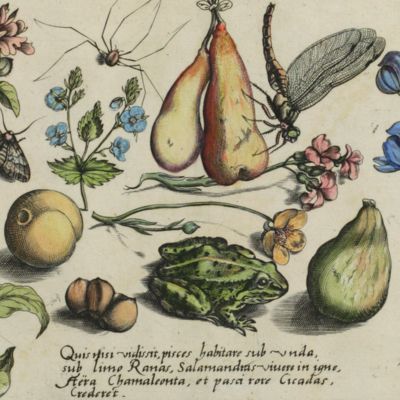An astonishing super-wide-margined complete set of this very rare work, which comprises four parts with 48 plates and four titles. The plates illustrate fruits, flowers - including tulips, irises, orchids - with many different snails, frogs, mice, crabs, etc., but above all, insects. This work is generally renowned for its finely executed entomological illustrations in particular. The Flemish painter and miniaturist Joris (Georgius) Hoefnagel (1542-1601) produced the
Archetypa during his Frankfurt Period, which was between 1591 and 1594. His son, Joris, made the engravings. "The
Archetypa were engraved as a reproduction of a collection of models and served in turn as a pattern book for other artists" (Vignau-Wilberg). According to Boychuck, the
Archetypa was "[p]ossibly a way for the elder Hoefnagel to execute works outside his commitment to the emperor, the collaboration of father and son served to extend Joris' particular artistic form to a wider audience while helping establish his son's artistic career". This work is not known in original colouring and was intended to be uncoloured. Later owners, however, often felt tempted to paint the delicate illustrations, nearly always resulting in fancy, unnatural coloration. Also, because all individual plates are quite attractive, many were framed and, therefore, complete suites, such as this one, have become very rare. Wilhelm Junk remarked that Hagen erred when the latter regarded Hoefnagel's
Diversae Insectarum Volatilium Icones (published in 1630) as rarer: "In Wirklichkeit sind heute vollständige Exemplare der 'Archetypa' wenn möglich noch seltener als die 'Diversae Icones". Martayan Lan once had a copy on leaves measuring 24.3 x 28.8 cm (i.e., large, although still much smaller than our copy), but usually the plates are found trimmed to the printed borders (ca. 15.0 x 20.5 cm), or with only a small margin. This suite is printed from the original plates, engraved by Joris Hoefnagel. The plates were aquired by Balthasar Caymox and then handed to the Nuremberg publisher Paulus Fürst, who had his name added, in very small letters, to the first title page, just outside the lower border. The fourth title page is unaltered, dated 1592. It may be regarded as a first edition, second printing. This copy has a few watermarks not mentioned by Vignau-Wilberg, including a post horn with, and another one without a letter S, and a vase or helmet with the letters C V H, a quartered shield with crown and the letters W M below, as well as the "double castle" described by Vignau-Wiberg. A few old, skilful repairs, otherwise near impeccable. As noted by Vignau-Wiberg for two copies of this edition (Amsterdam, Rijksprentenkabinet, and Berlin, Kupferstichkabinett, this copy has sharp, fresh impressions. A wonderful copy. In the 18th century, the plates were used once again, but by then the quality of the plates was noticeably lower, especially regarding the finer details. Boychuck, J.
read more
(2016),
Multo in Parvo: Joris Hoefnagel’s illuminations and the gathered practices of central European court culture (thesis); Brunet 3, p. 244; Hagen I, p. 371; Hollstein IX, 17-64; Horn-Schenkling, 10472; Junk,
Rara, p. 30; Nissen ZBI, 1954; Vignau-Wilberg (1994),
Archetypa Studiaque Patris, Georgii Hoeffnagelii, 1592: Nature, Poetry and Science in Art Around 1600, Staatliche Graphische Sammlung München.
read less
![Archetypa studiaque patris Georgii Hoefnagelii Iacobus F. genio duce ab ipso scalpta, omnibus philomusis amica D: ac perbenique communicat. I. Chr. Weigel excudit. [Complete with all titles and plates].](https://www.schierenberg.nl/media/cache/product_thumb/77260/77260_x.jpg)

![image for Index Litteraturae Entomologicae Serie I: de Welt-Literatur über die gesamte Entomologie bis inklusive 1863. [Interleaved set with additions].](https://www.schierenberg.nl/media/cache/product_thumb/76790/76790.jpg)



